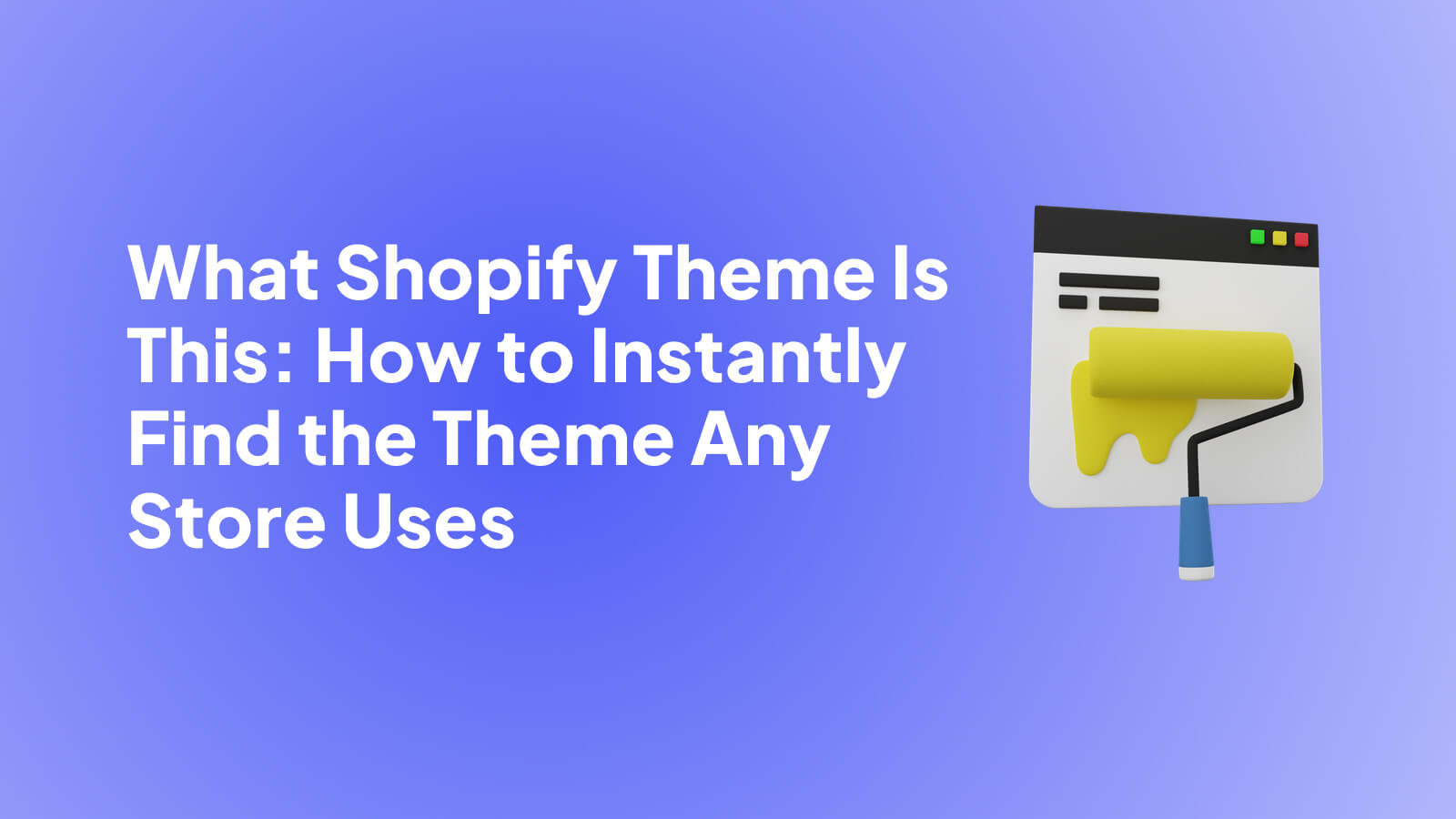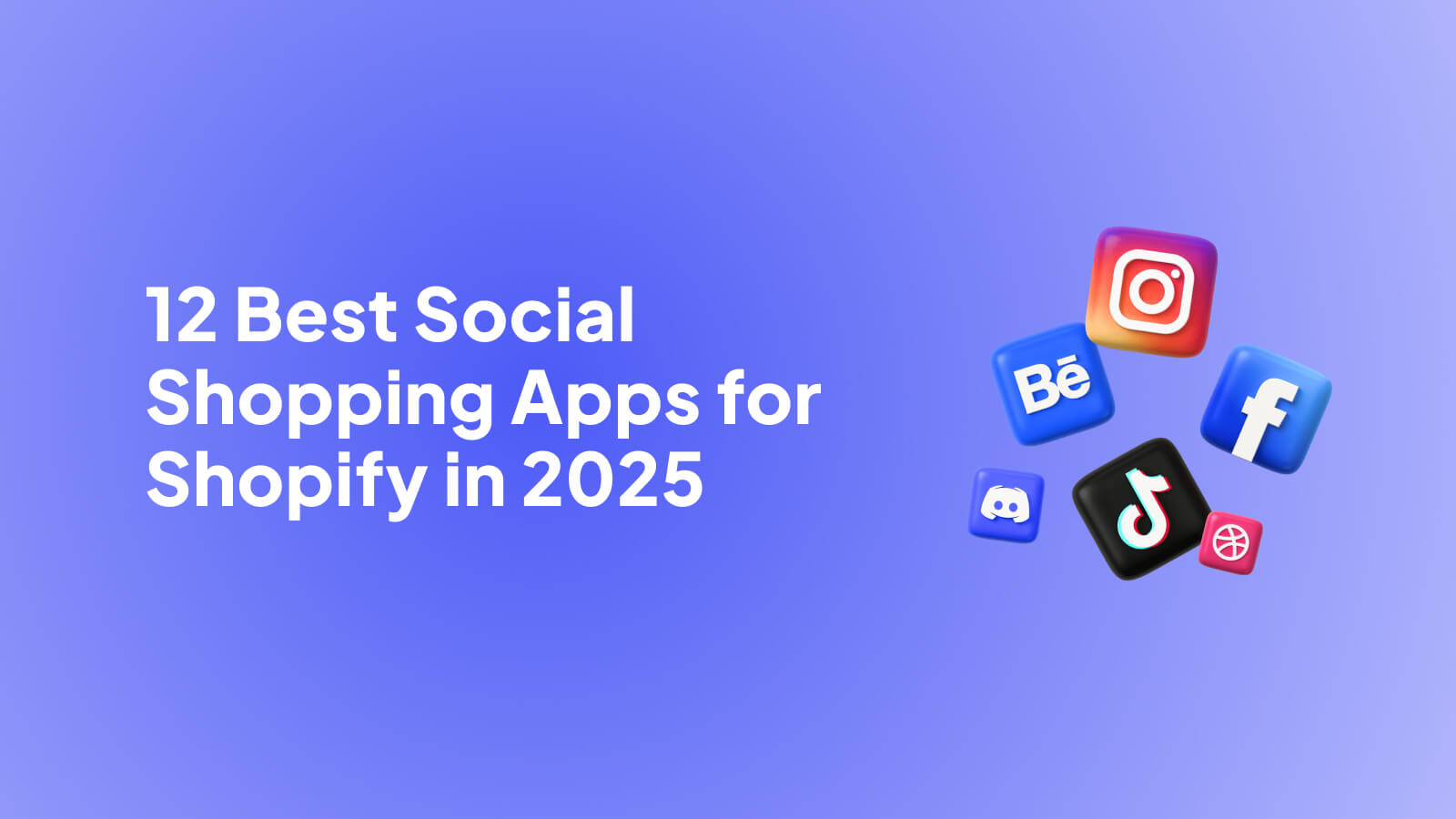
The line between social media and e-commerce has blurred, creating a powerful new channel known as social commerce. For Shopify merchants, navigating the growing ecosystem of social shopping apps can be overwhelming. Which platforms genuinely drive sales, and which are just passing trends? This guide cuts through the noise to provide a detailed, practical breakdown of the top social commerce platforms available today. We’ll move beyond marketing jargon and offer a direct comparison of features, pricing structures, and real-world use cases for each app.
This resource is designed to help you make an informed decision for your specific business needs. Whether you're looking to leverage user-generated content with Moast, master live selling on TikTok Shop, or build a shoppable presence on Instagram, we've got you covered. Each entry includes an honest assessment of its pros and cons, integration tips for your Shopify store, and screenshots to show you exactly how it works. You will find direct links to each platform, so you can start exploring immediately. Our goal is to equip you with the insights needed to select and implement the right social shopping apps to effectively engage customers and boost your revenue.
1. Moast
Moast establishes itself as a premier choice among social shopping apps, offering a powerful and uniquely accessible solution for Shopify merchants. It specializes in transforming authentic video content-like user-generated content (UGC), Instagram Reels, and TikToks-into interactive, shoppable widgets directly on your store. This seamless integration allows brands to leverage the power of social proof and video marketing to create a more dynamic and engaging customer journey, ultimately driving conversions and enhancing brand trust.
What truly sets Moast apart is its revolutionary pricing model: it is 100% free with unlimited video views. This eliminates the financial barrier to entry that many merchants face, providing enterprise-grade functionality without the usage caps or hidden fees common with other platforms. The setup process is remarkably efficient, taking less than five minutes to get fully operational.
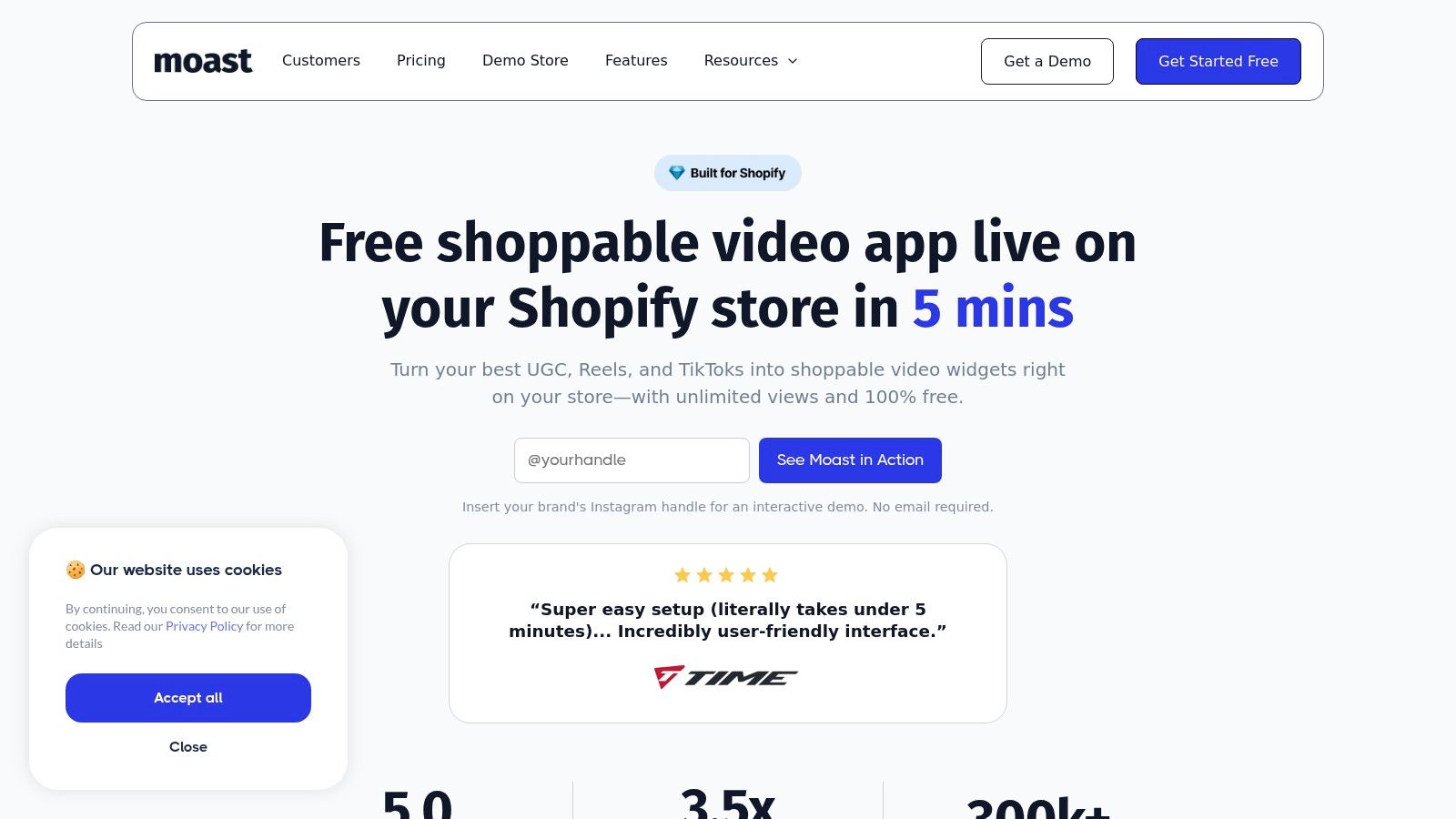
Key Features and Strengths
Moast's feature set is designed for maximum impact with minimal effort. It empowers merchants to automatically import video content from Instagram and TikTok or perform bulk uploads, streamlining the content management process.
Real-World Impact: With an average conversion lift of 17%, Moast delivers measurable results. Its ability to integrate with review platforms like Judge.me and Loox supercharges social proof by displaying star ratings directly on video widgets, building shopper confidence at the point of decision.
The platform offers a versatile range of customizable widgets, including carousels, stories-style pop-ups, and grids. This flexibility ensures that the shoppable video experience aligns perfectly with your brand’s aesthetic and your store’s layout, whether on product pages, the homepage, or a dedicated "Shop Our Instagram" page.
Practical Implementation
- Best For: Shopify merchants of all sizes, especially DTC brands looking to boost conversion rates and engagement using authentic video content without incurring additional software costs.
- Implementation Tip: Use the "Stories" widget on your homepage to immediately capture visitor attention with fresh UGC. On product pages, deploy the "Carousel" widget to showcase product-specific videos and reviews, providing targeted social proof where it matters most.
Feature AnalysisKey BenefitUnlimited Free PlanEliminates budget constraints and allows for unrestricted growth and experimentation.Automated Social ImportsSaves significant time by syncing your best Instagram and TikTok content effortlessly.Review App IntegrationBoosts credibility by pairing authentic video testimonials with verified product ratings.Customizable WidgetsMaintains brand consistency and optimizes user experience across your entire site.
Pros:
- Completely free with no limits on video views, making it the most generous offering in the market.
- Extremely fast and intuitive setup process completed in under five minutes.
- Seamlessly imports UGC from Instagram and TikTok, plus supports bulk uploads.
- Multiple customizable widget options (carousel, stories, pop-up, grid) to fit any store layout.
- Integrates with top review platforms to automatically display product ratings and enhance shopper trust.
Cons:
- Currently exclusive to the Shopify platform, so merchants on other ecommerce systems cannot use it.
- Advanced customization beyond the provided widget options may require some CSS knowledge.
Website: https://www.moast.io
2. TikTok Shop
TikTok Shop has rapidly transformed the platform from a pure entertainment app into a formidable e-commerce force. It merges viral discovery directly with on-platform purchasing, allowing Shopify merchants to capitalize on trends in real-time. The core strength lies in its seamless integration into the user experience, where products appear natively in For You feeds, livestreams, and creator profiles.
What makes TikTok Shop one of the most powerful social shopping apps is its native checkout process. Customers can complete a purchase with just a few taps without ever leaving the app, dramatically reducing friction and boosting conversion rates. This feature, combined with an expansive creator affiliate network, allows brands to leverage authentic user-generated content for promotion. Creators can link directly to products, earning commissions and driving sales through genuine, engaging video reviews.
Key Features & Considerations
- Integration: Connects directly with Shopify, allowing for inventory sync and order management.
- Discovery Engine: Products gain visibility through TikTok's powerful recommendation algorithm.
- Creator Affiliate Program: A built-in marketplace connects merchants with creators to promote products authentically.
- Live Shopping: Host real-time selling events featuring exclusive deals and direct audience interaction.
Pros: Unmatched potential for viral product discovery; strong creator ecosystem drives authentic marketing.
Cons: Seller quality and shipping times can be inconsistent, potentially impacting brand reputation.
Best for: DTC brands with visually appealing products that can go viral, especially those in beauty, fashion, and home goods. For merchants looking to maximize their presence, mastering the ad platform is crucial. You can learn more about crafting effective campaigns with these 10 best TikTok shopping ad strategies.
Website: https://www.tiktok.com/shop
3. Instagram Shop (Meta)
Instagram has evolved from a photo-sharing app into a comprehensive visual marketplace, deeply integrating commerce into its social fabric. Through product tags, shoppable Reels, and dedicated brand storefronts, it allows merchants to turn inspirational content directly into sales opportunities. The platform excels at creating a seamless journey from discovery to consideration, all within a highly engaged visual environment.
What makes Instagram one of the leading social shopping apps is its ability to embed commerce naturally into the user's daily feed. Customers can tap a product tag in a post, explore it in more detail, and either complete the purchase on the merchant’s site or, for eligible businesses, through Meta’s native checkout. This versatility, combined with powerful creator collaboration tools, allows brands to leverage influencer marketing and user-generated content to build trust and drive conversions.
Key Features & Considerations
- Product Tagging: Tag products directly in posts, Stories, Reels, and live broadcasts for easy discovery.
- Curated Shop Tab: A dedicated shopping destination where users can browse trends, new arrivals, and collections from brands they follow.
- Creator Collaborations: Enables creators to tag products and earn affiliate commissions, amplifying brand reach authentically.
- In-App Messaging: Facilitates direct communication between buyers and sellers for inquiries and customer support.
Pros: Creates beautiful, visual storefronts in a high-engagement environment; extensive reach across a diverse user base.
Cons: Native checkout is not available for all merchants, sometimes redirecting users to external sites; product discovery is heavily reliant on the algorithm.
Best for: Visually driven brands in fashion, beauty, home decor, and lifestyle that have a strong content strategy and want to leverage a large, built-in audience.
Website: https://www.instagram.com/shop
4. Facebook Shops (Meta)
Facebook Shops provides merchants with a unified digital storefront accessible across both Facebook and Instagram, two of the world's largest social networks. This integration allows brands to upload a single product catalog that powers a seamless shopping experience on both platforms, tapping into a massive, diverse user base. The strength of this ecosystem lies in its ability to connect social discovery in community groups and feeds directly with commerce.
What makes Facebook Shops one of the most established social shopping apps is its mature infrastructure for social selling. Merchants can leverage powerful ad retargeting through Meta Ads, engage customers via built-in messaging for direct sales conversations, and host live shopping events for product drops. While checkout can be completed on-platform in eligible regions, many merchants use it to direct qualified traffic to their Shopify store, blending social engagement with their primary sales channel.
Key Features & Considerations
- Unified Catalog: Manage a single catalog for both Facebook and Instagram Shops, simplifying inventory management.
- Live Shopping: Integrate product tags into live video streams to showcase items and drive real-time purchases.
- Messaging Commerce: Use Messenger and Instagram DMs to answer questions, provide support, and complete sales.
- Advanced Ad Integration: Leverage deep user data within the Meta Ads platform for highly targeted promotions and retargeting campaigns.
Pros: Access to an enormous and varied audience; sophisticated ad tools allow for precise customer targeting.
Cons: The checkout experience and interface can vary significantly by region and merchant setup, sometimes creating inconsistency.
Best for: Brands with a strong community presence on Facebook or Instagram looking to convert followers into customers. It excels for merchants who want to use social platforms for top-of-funnel discovery and drive traffic back to their primary website.
Website: https://www.facebook.com/shops
5. Pinterest Shop
Pinterest has evolved from a visual discovery engine into a powerful commerce platform, particularly for categories driven by aesthetics and planning. It serves as a digital mood board where users actively search for inspiration, making it a high-intent environment for merchants in home decor, fashion, and DIY. Unlike impulse-driven platforms, Pinterest captures users during the consideration and planning phase of their purchasing journey.
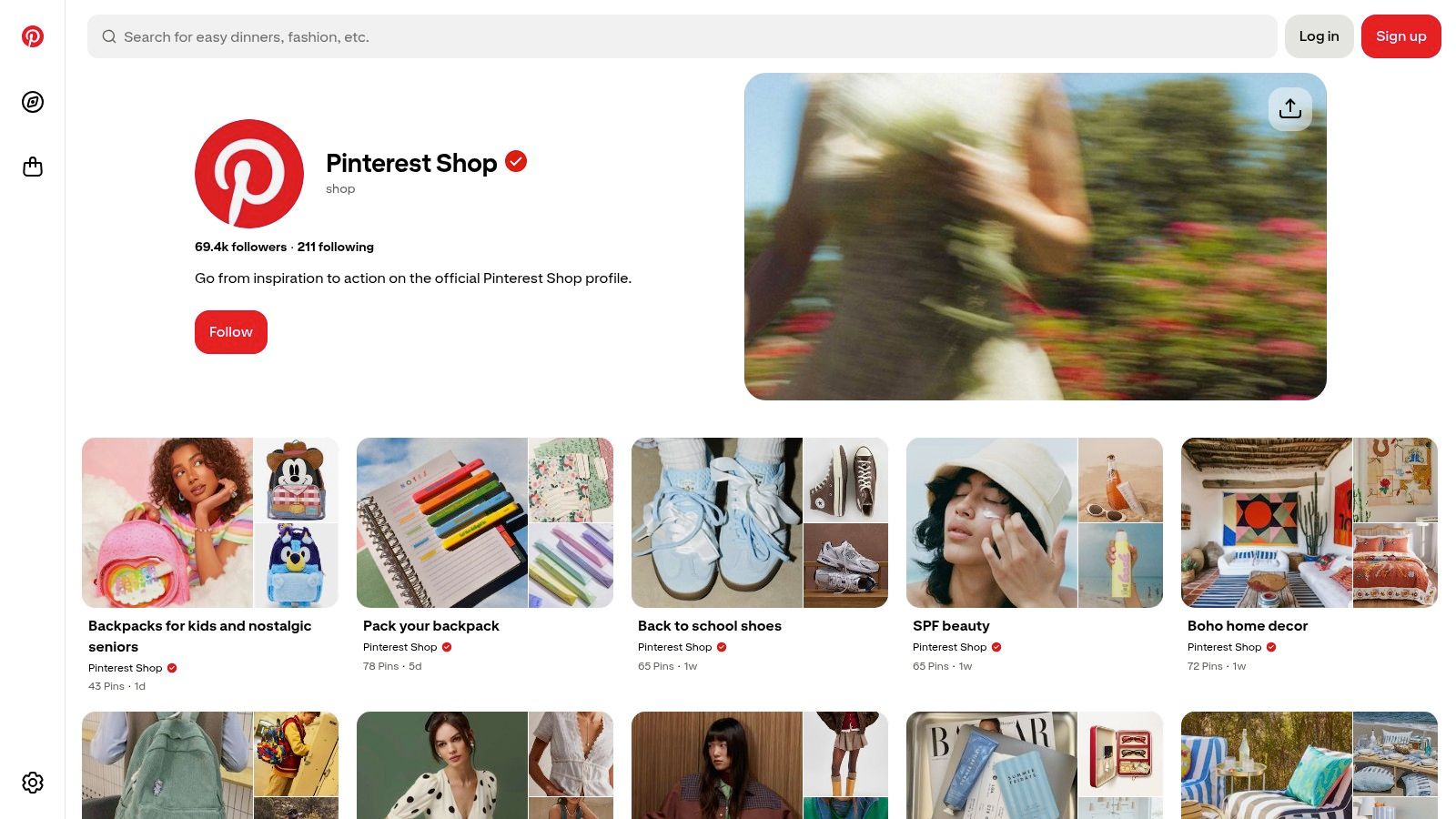
The platform's strength lies in its long-term content value and its function as one of the most visually-driven social shopping apps. Shoppable Pins allow merchants to tag products directly in images, pulling real-time pricing and stock information from their Shopify stores. This transforms inspirational content into direct purchase opportunities, connecting a user's vision to a tangible product. The visual search technology further enhances this, allowing users to find similar products based on an image, creating a seamless path from discovery to checkout.
Key Features & Considerations
- Shoppable Pins: Tag products in static images and videos, displaying live pricing and availability.
- Visual Search: "Shop with Lens" lets users take a photo or use an existing Pin to find and buy similar items.
- Brand Storefronts: Curate product collections on a dedicated Shop tab on your profile, acting as a digital catalog.
- Idea Pins: Use multi-page video or image formats to create tutorials and lookbooks that can feature tagged products.
Pros: High-intent audience actively planning purchases; excellent for evergreen content and long-term traffic.
Cons: Most transactions complete off-platform on the merchant's site, adding a step to the conversion funnel.
Best for: Brands in visually-driven niches like home goods, fashion, weddings, and crafts. Success relies on creating high-quality, aspirational imagery that inspires users to save and plan.
Website: https://www.pinterest.com/shop
6. Amazon Live
Amazon Live leverages the retail giant's immense customer trust and logistics network to create a powerful live-stream shopping experience. Instead of integrating with a separate social platform, it brings the social, interactive element directly into the Amazon ecosystem. Brands and influencers host live streams to demonstrate products, answer questions in real-time, and offer limited-time deals, all within an environment where customers are already primed to purchase.
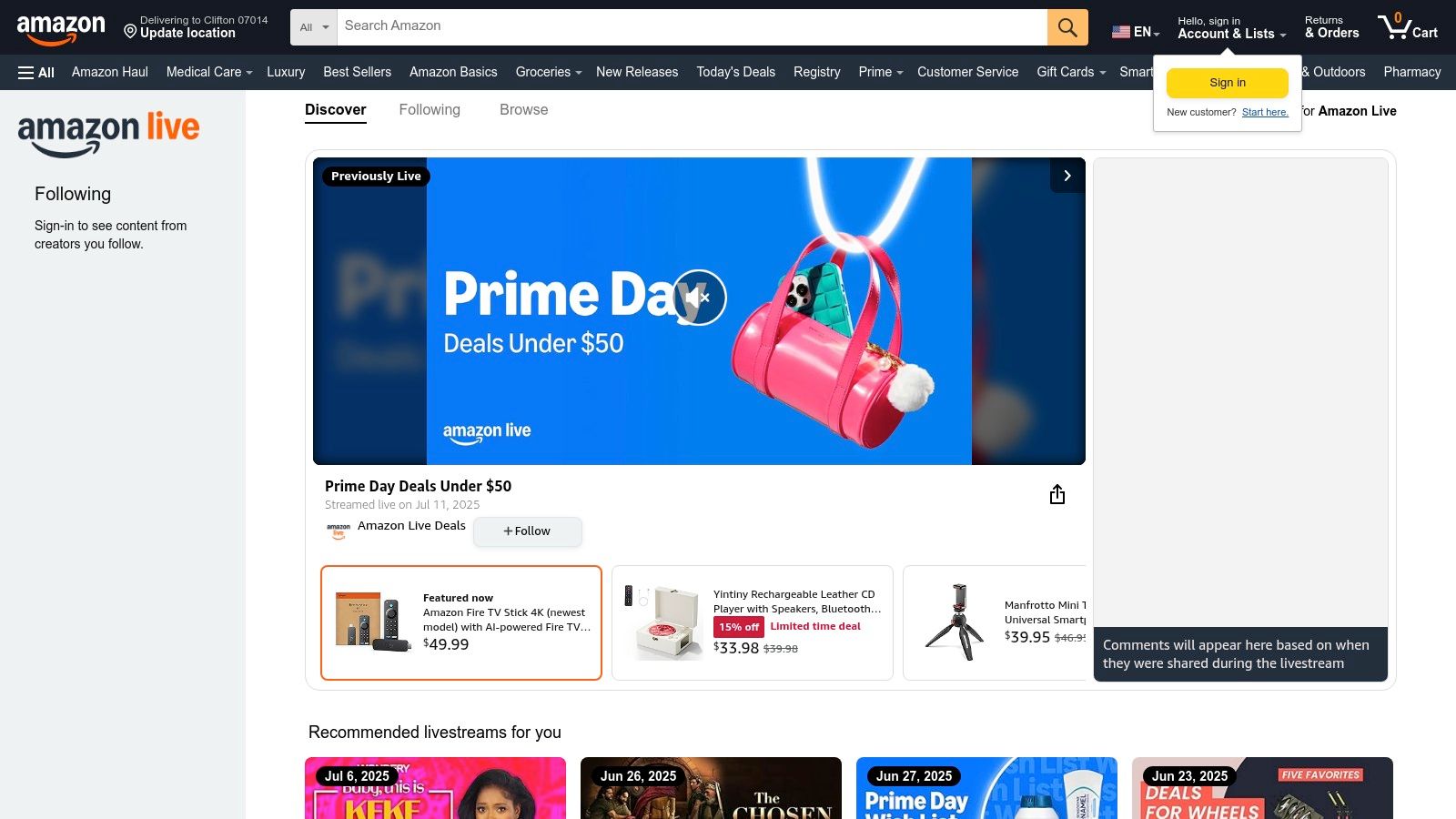
What makes Amazon Live one of the most compelling social shopping apps for established merchants is its direct tie-in with Prime. Viewers can add products to their cart and check out using their existing Amazon account, benefiting from familiar Prime shipping and easy returns. This seamless transaction process, combined with the credibility of Amazon reviews displayed alongside the stream, significantly reduces purchase anxiety and builds instant confidence, making it a highly effective channel for conversion-focused live events.
Key Features & Considerations
- Native Amazon Integration: Streams are linked directly to product detail pages, leveraging Amazon's trust, reviews, and Prime shipping.
- Live Promotions: Hosts can create exclusive, stream-only promo codes to drive urgency and immediate sales.
- Amazon Influencer Program: Brands can collaborate with approved Amazon influencers to host streams and reach new, relevant audiences.
- Real-Time Chat: Engage directly with potential customers, answer questions, and overcome objections during the live broadcast.
Pros: Capitalizes on massive built-in customer trust and the convenience of Prime; simplified checkout process leads to higher conversions.
Cons: Discovery can be challenging as streams are somewhat buried within the Amazon site; the format often feels more like QVC than a native social feed.
Best for: Brands already selling on Amazon who want to add an interactive, high-conversion sales channel. It is especially effective for product demonstrations in categories like electronics, kitchen gadgets, and beauty tools.
Website: https://www.amazon.com/live
7. Whatnot
Whatnot has carved out a unique and powerful niche in the social commerce space by focusing on live, auction-style shopping for collectibles. Primarily centered around categories like trading cards, comics, vintage clothing, and sneakers, it recreates the high-energy, community-driven atmosphere of a physical collectibles show. The platform's real-time auction format generates excitement and urgency, turning shopping into a thrilling live event.
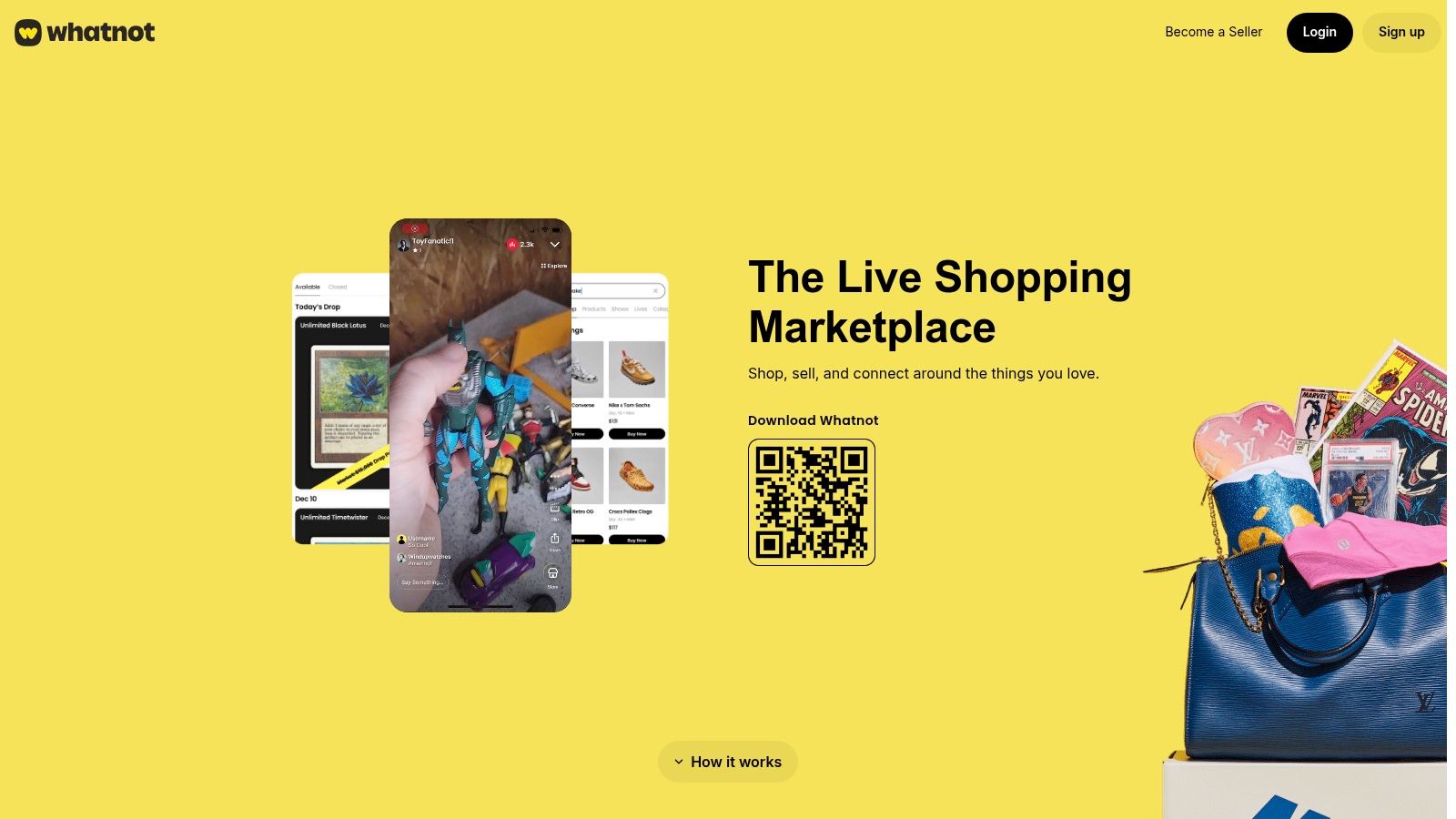
What makes Whatnot one of the most engaging social shopping apps is its deep integration of community and live video. Sellers build loyal followings by hosting scheduled shows, and buyers participate through live chat, creating a dynamic social environment. Seller verification and category-specific rules help maintain trust, while integrated payment and shipping solutions streamline the transaction process for both parties. These elements combine to form an experience that is less about passive browsing and more about active, event-based participation.
Key Features & Considerations
- Live Auctions: Features real-time bidding alongside "Buy It Now" options during streams.
- Seller Verification: Implements a vetting process and category-specific rules to build marketplace trust.
- Integrated Logistics: Provides in-app payment processing, shipping label generation, and dispute handling.
- Community Engagement: Built-in community chat and show schedules foster direct interaction and viewer loyalty.
Pros: Creates a highly engaging live auction experience for collectors; fosters niche communities with specialized sellers and events.
Cons: The fast-paced auction dynamic can lead to impulse purchases; shipping speed and packaging quality vary significantly by seller.
Best for: Sellers specializing in collectibles, vintage items, and other niche product categories with a strong community element. Success on the platform relies on building a personal brand and consistently hosting engaging live shows. You can explore similar concepts in these shoppable video examples.
Website: https://www.whatnot.com
8. Poshmark (incl. Posh Shows)
Poshmark has established itself as a leading social resale marketplace, centered around a vibrant community passionate about fashion, home goods, and beauty. Its platform is built on social interactions like following, sharing, and commenting on user-managed "closets," which drives discovery and engagement. The recent introduction of Posh Shows brings live shopping to the forefront, allowing sellers to host real-time auctions and drops.
What cements Poshmark's place among top social shopping apps is its community-driven sales model. Unlike traditional e-commerce, sales are often fueled by peer-to-peer sharing and social proof within the app. The platform simplifies logistics with prepaid, flat-rate shipping labels and offers buyer protection, creating a trusted environment for secondhand commerce. This blend of social networking and streamlined transactions makes it a unique channel for both individual sellers and boutique brands.
Key Features & Considerations
- Social Commerce: Users can follow closets, share listings to their own followers, and participate in themed "Posh Parties."
- Posh Shows: Live-streamed selling events featuring rapid auctions and direct interaction between sellers and buyers.
- Simplified Shipping: Provides prepaid shipping labels for most items, streamlining the fulfillment process for sellers.
- Buyer Protection: A robust policy, Posh Protect, ensures buyers can open a case if an item is not as described.
Pros: Strong, engaged community that actively promotes listings; simplified shipping and payment processing.
Cons: Primarily focused on secondhand goods, which may not fit all brand models; selling can be time-intensive due to social engagement demands.
Best for: Boutique brands, individual resellers, and merchants liquidating past-season inventory in fashion, accessories, and home decor. Success relies heavily on active community participation and consistent listing.
Website: https://poshmark.com
9. Depop
Depop has carved out a significant niche as a fashion-forward marketplace that feels like a blend of Instagram and eBay. It thrives on a community-driven model where users follow individual sellers, creating a highly personalized shopping feed filled with unique vintage finds, streetwear, and Y2K-inspired styles. The platform’s strength lies in its social dynamics; users can "like," comment on, and message sellers directly about items, fostering a direct connection that traditional e-commerce sites lack.
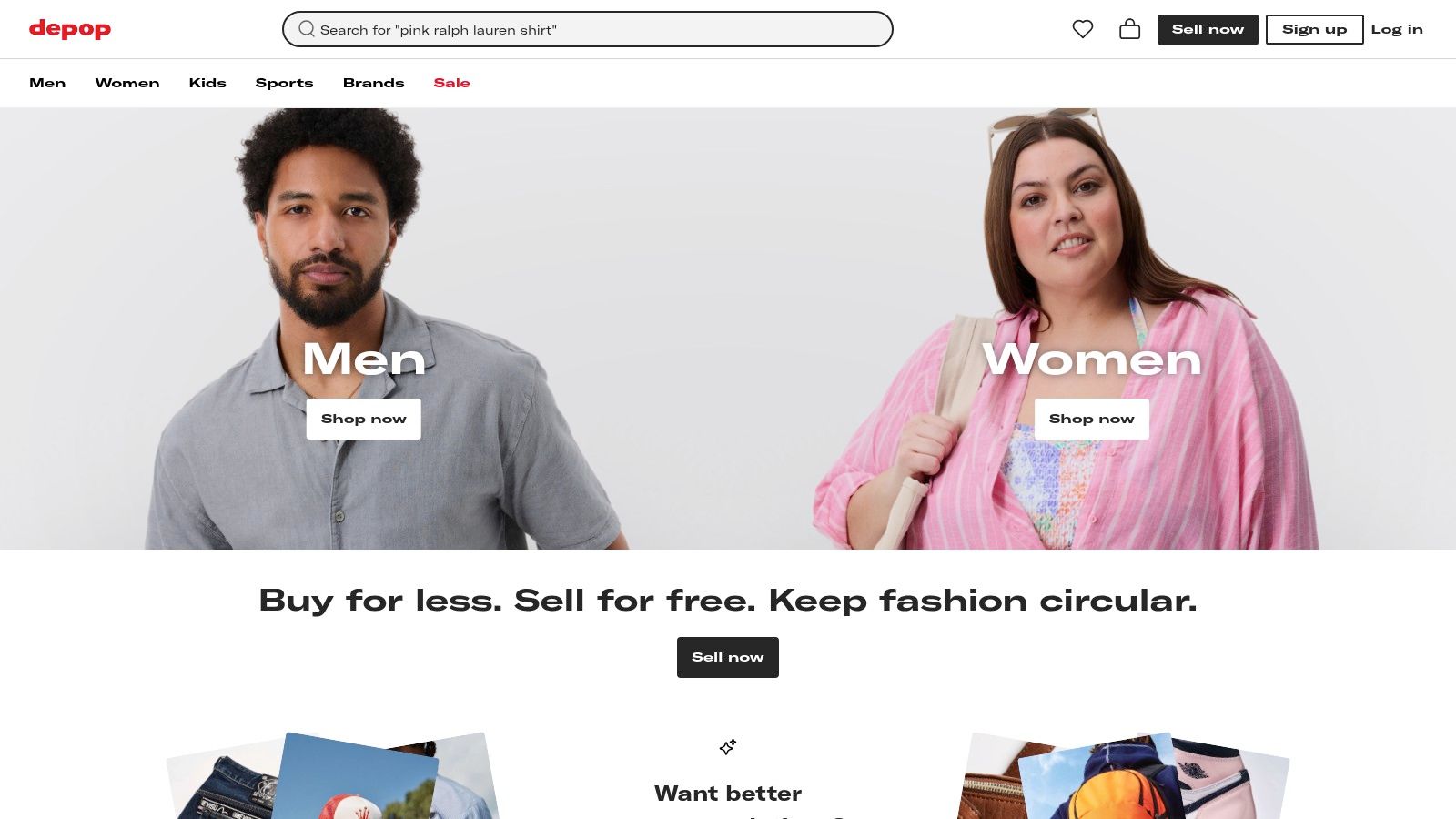
What makes Depop one of the most compelling social shopping apps is its ability to incubate micro-trends. Independent sellers and creators often popularize specific styles long before they hit mainstream retail. Its user interface, centered around image-heavy profiles and an "Explore" page, encourages discovery and impulse buys. This focus on individual curators and one-of-a-kind items makes it an invaluable platform for shoppers seeking to express unique personal style rather than just consuming mass-market trends.
Key Features & Considerations
- Instagram-like Profiles and Feeds: Sellers build a following by curating a visual storefront, complete with likes and follower counts.
- Messaging, Offers, and Seller Ratings: Direct communication tools allow for negotiation and building trust through community feedback.
- In-app Checkout and Shipping Tools: Streamlined purchasing and integrated shipping options simplify the transaction process for both parties.
- Trend Discovery: An active Explore page and robust hashtag system help users find emerging styles and niche aesthetics.
Pros: Stronghold for unique, creator-led styles and micro-trends; excellent platform for sourcing vintage and one-of-a-kind items.
Cons: Sizing and item condition can vary widely; returns are dependent on individual seller policies, and buyer protection requires strict adherence to platform rules.
Best for: Fashion-conscious consumers and small sellers specializing in second-hand, vintage, or upcycled apparel. Its community-first approach makes it stand out among other leading social commerce platforms.
Website: https://www.depop.com
10. NTWRK
NTWRK carves out a unique niche in the social commerce space by focusing on hype-driven, curated live shopping events. The platform is structured like a TV network for "shoppertainment," featuring scheduled shows hosted by creators and celebrities that culminate in exclusive, limited-edition product drops. This approach targets culture-focused consumers interested in streetwear, collectibles, art, and designer collaborations that are often unavailable elsewhere.
What makes NTWRK stand out among social shopping apps is its editorialized, high-production-value content. Instead of user-generated feeds, it offers a polished, appointment-viewing experience that builds anticipation and urgency. The integrated checkout allows viewers to purchase highly sought-after items directly within the app the moment they drop, creating a fast-paced, competitive shopping environment that mirrors the excitement of in-person "hype" releases.
Key Features & Considerations
- Scheduled Drops: Live shows are scheduled in advance, with app notifications to build audience anticipation.
- Limited Exclusives: Focuses on rare collaborations and limited runs that sell out quickly.
- Creator & Celebrity Hosts: Features well-known figures from art, music, and fashion to host shows and drive engagement.
- Integrated Checkout: Seamless in-app purchasing and order tracking to facilitate fast transactions during live drops.
Pros: Access to exclusive, culture-focused products and unique brand collaborations; engaging, high-quality shopping shows.
Cons: Very limited quantities lead to quick sellouts and potential frustration; narrow category focus may not suit all brands.
Best for: Brands in the streetwear, collectibles, and art verticals looking to launch exclusive, high-demand products to a dedicated, culture-savvy audience.
Website: https://www.thentwrk.com
11. TalkShopLive
TalkShopLive operates as a versatile live shopping platform that empowers creators, brands, and publishers to host shoppable video events. Its primary distinction is its syndication capability, allowing a single live show to be embedded across multiple websites, blogs, and social media channels simultaneously. This widens the potential audience far beyond a single app ecosystem, making it a powerful tool for broadcasting widely.

Unlike closed-platform social shopping apps, TalkShopLive is built for distribution. Merchants can leverage its technology to create a live commerce event on their own Shopify site while also simulcasting to other platforms. The platform's in-video checkout is designed to capture impulse buys by allowing viewers to purchase products directly within the video player, regardless of where it’s embedded. This flexibility makes it an excellent choice for established brands with existing audiences across various digital properties.
Key Features & Considerations
- Embeddable Player: Shoppable video can be placed on any website or blog, turning existing traffic into a live shopping audience.
- Multi-channel Simulcasting: Broadcast a single live event across multiple social media channels and websites at once.
- In-Video Checkout: A seamless purchase flow allows customers to buy products directly within the video stream.
- Creator & Publisher Network: Collaborate with established media publishers and creators to co-host shows and reach new audiences.
Pros: Unmatched syndication allows for broad reach beyond a single app; strong in a variety of categories including books, beauty, and food.
Cons: The native audience is smaller than giants like TikTok or Instagram; discovery is highly dependent on event promotion rather than an algorithmic feed.
Best for: Brands and publishers with established audiences across multiple channels who want to add a live shopping layer to their existing digital footprint.
Website: https://talkshop.live
12. LTK (LIKEtoKNOW.it)
LTK, formerly LIKEtoKNOW.it, operates as a massive creator-guided shopping platform that bridges the gap between influencer content and retail. It aggregates shoppable images and videos from thousands of creators across fashion, home, and beauty, allowing consumers to discover and purchase the exact products featured in the content they admire. For merchants, LTK offers a powerful affiliate channel to get products in front of high-intent buyers through a network of trusted style leaders.
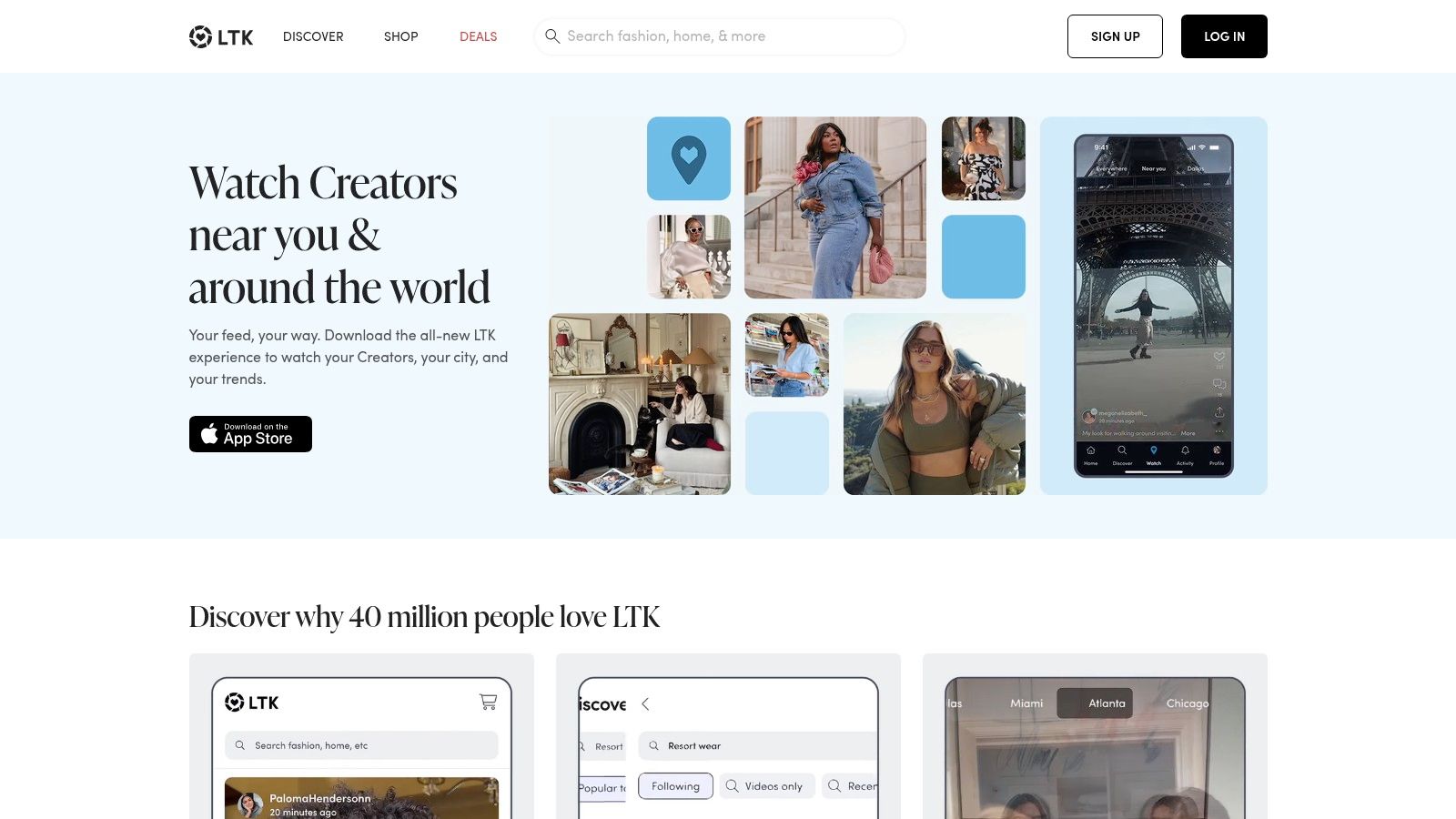
What makes LTK one of the most established social shopping apps is its focus on a curated, high-trust environment. Unlike open platforms, sales are driven by creators with established audiences who are actively seeking product recommendations. The app’s "shop the look" functionality, complete with links to exact items or similar alternatives, provides a seamless discovery experience. This direct link from inspiration to transaction makes it a vital tool for brands aiming to leverage influencer marketing effectively.
Key Features & Considerations
- Creator Storefronts: Influencers curate their own digital shops featuring their favorite products and collections.
- Retailer Integrations: Connects with thousands of brands and retailers, allowing for broad product inclusion.
- Shop-the-Look: Users can instantly shop for items seen in creator posts, with links to exact matches or similar products.
- Price & Restock Alerts: Shoppers can favorite items and receive notifications for sales or when an out-of-stock item becomes available.
Pros: High signal for trend and product discovery via trusted creators; useful alerts and alternatives reduce out-of-stock frustration.
Cons: Most purchases are completed on external retailer sites, adding a step to checkout; the best user experience requires following specific creators.
Best for: Fashion, beauty, and home decor brands looking to tap into a robust, high-conversion affiliate marketing network driven by established influencers.
Website: https://www.shopltk.com
Social Shopping Apps Comparison Guide
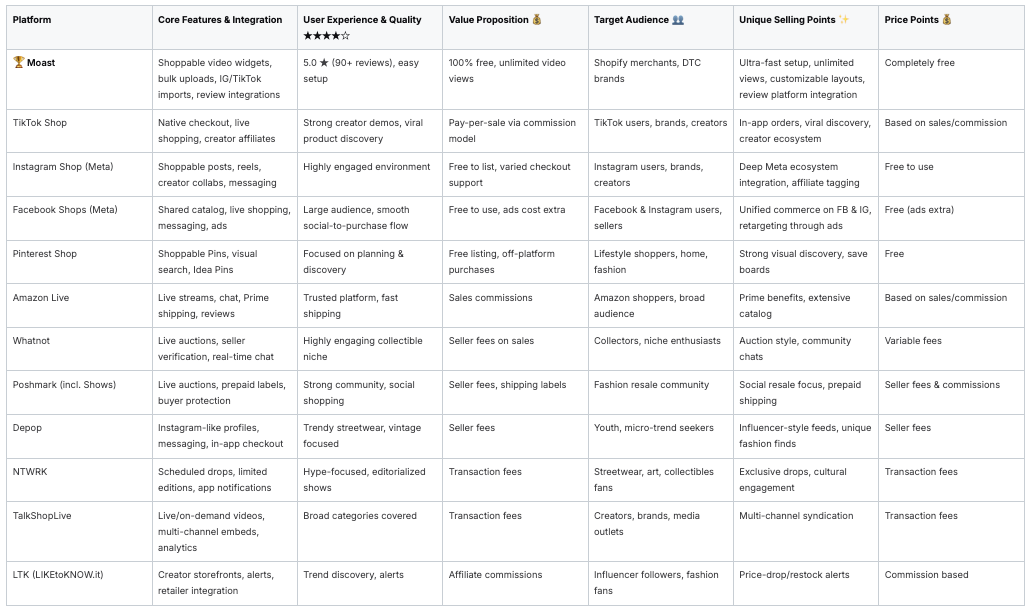
Final Thoughts
Navigating the dynamic landscape of social shopping apps can feel like exploring a bustling, ever-expanding digital city. Each platform, from the vast marketplaces of Meta and TikTok to the niche, community-driven worlds of Poshmark and NTWRK, offers a unique avenue to connect with customers where they already spend their time. The key takeaway from our deep dive is that there is no single "best" app; instead, the ideal strategy involves a carefully selected mix that aligns with your specific brand, audience, and operational capacity.
The rise of these platforms signifies a fundamental shift in e-commerce. Shopping is no longer a transactional, solitary activity. It's an interactive, community-centric experience driven by discovery, entertainment, and trust. Integrating the right social shopping apps into your Shopify store isn't just about opening a new sales channel; it's about embedding your brand directly into the cultural fabric of your target demographic.
How to Choose Your Social Shopping Stack
Selecting the right combination of tools requires a strategic approach. Before you commit, consider these critical factors to guide your decision-making process:
- Audience Alignment: Where does your ideal customer spend their time online? A brand targeting Gen Z with trendy apparel will find a natural home on TikTok Shop and Depop, while a home decor brand might see greater success with the visually-driven discovery on Pinterest and the aspirational communities within LTK.
- Content Production Capacity: Be realistic about your resources. Live selling on platforms like Whatnot or Amazon Live demands a consistent schedule, on-camera talent, and a certain level of production. In contrast, tools like Instagram Shops can be managed effectively with high-quality static images and short-form video content you may already be creating.
- Product-Platform Fit: Your product type is a major determinant of success. High-consideration or complex products can benefit from long-form educational content on TalkShopLive, while collectible or limited-drop items thrive in the fast-paced, auction-style environment of NTWRK.
- Integration and Workflow: How seamlessly does the app integrate with your existing Shopify setup? Evaluate the ease of syncing inventory, managing orders, and tracking analytics. A clunky integration can create more operational headaches than the new sales channel is worth.
Your Actionable Next Steps
To move forward, start small and scale intelligently. Don't try to master all twelve platforms at once.
- Identify Your Top 2-3 Platforms: Based on the criteria above, select a few promising candidates.
- Run Pilot Programs: Dedicate a specific period (e.g., 30-60 days) to test each one. Track key metrics like engagement, traffic, conversion rates, and, most importantly, return on time invested.
- Gather Direct Customer Feedback: Ask your audience where they want to shop and interact with you. Use polls on Instagram Stories or email surveys to get direct insight.
- Refine and Optimize: After your pilot phase, analyze the results. Double down on what works and don't be afraid to discard what doesn't.
The world of social commerce is your oyster. By thoughtfully choosing and implementing the right social shopping apps, you can transform your Shopify store from a simple online retailer into a vibrant, community-driven brand that thrives at the intersection of content and commerce.
Ready to elevate your product pages and bridge the gap between social proof and on-site conversion? Moast helps you embed dynamic, authentic user-generated content and shoppable video galleries directly into your Shopify store, capturing the essence of social shopping where it matters most. Transform your product discovery experience by visiting Moast to see how you can turn social buzz into sales.
Related content
Turn your videos into sales
Boost conversions by up to 30% by turning your existing TikToks and Reels into shoppable videos directly on your Shopify store.





